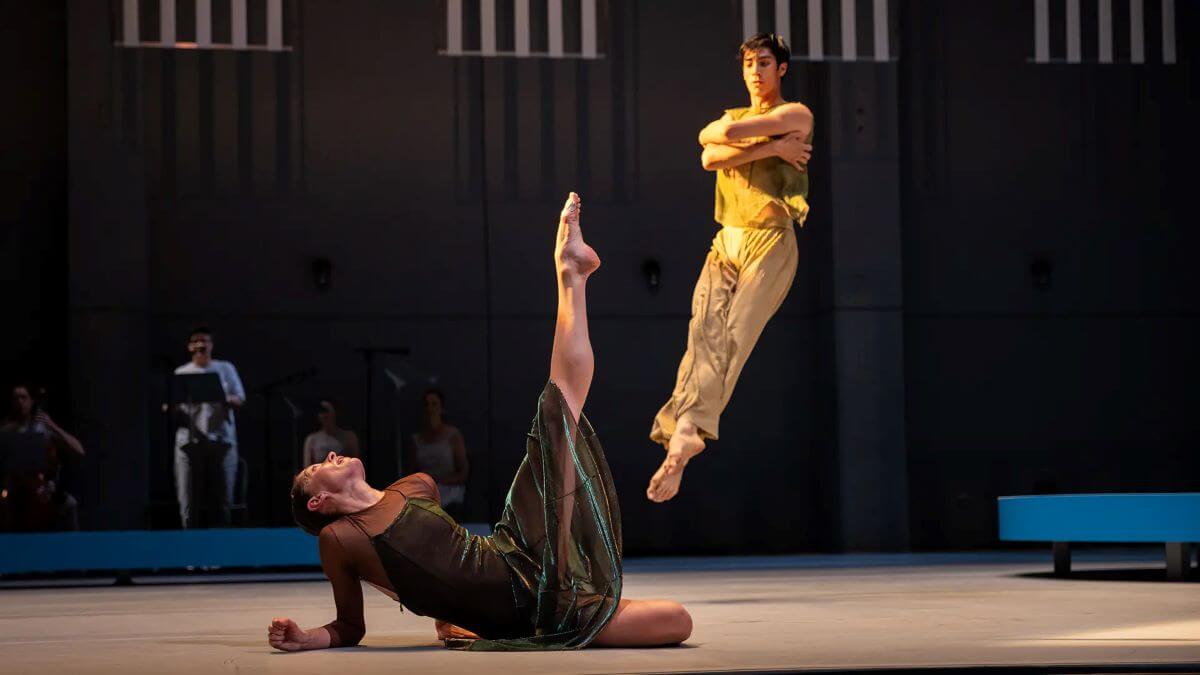
Mining Hope in What Lies Between: Pam Tanowitz Reimagines Song of Songs

I found myself of two minds when I heard that New York’s City Center was putting on a modern dance performance of the biblical book Song of Songs. Having studied the Hebrew scriptures in grad school, I’m always intrigued by how those texts inspire artists. And yet, knowing that Song of Songs is basically a love poem expressed by two lovers, I also wondered just how much there was that could be done with it.
As it turns out, Song of Songs choreographer Pam Tanowitz had similar concerns. “I think a lot of people coming were expecting Romeo & Juliet,” she told me in a phone interview after the show. “Why would I do that? That’s not interesting.”
The thing that Tanowitz liked about Song of Songs, in fact, was how free it enabled her to be. Interpretations of the poem, she notes, “change with whatever framework you want to put around it. Different scholars say it’s either about that [erotic love] or it’s about your relationship with God.” Having come off of transforming T. S. Eliot’s famous poem “Four Quartets” into dance, a show where “I had to do the poem verbatim or I couldn’t do it at all,” Songs’ breadth felt liberating. “With Song of Songs we could do whatever we wanted.”
As the performance begins, three singers offer phrases from the Song of Songs. Crafted by composer David Lang, who did the music for the show, the words are often sensual. “Just your mouth … just your love … just your anointing oils …” And yet, on stage there’s a single dancer whose movement does not at all suggest a sense of eros. I kept thinking of a young person exploring what they’re capable of and running up against external boundaries.
Eventually, a second dancer emerges. The two dance together for a time, but again without any real sense of the romantic. And then unexpectedly the performance broadens to include a whole group who take turns dancing or watching others do so. Sometimes the whole group dances together, or holds hands and spins in a circle, like children on a playground at recess. But what’s most striking is the way in which the dancers seem to liberate each other, one’s self-expression calling others into their own specific movements and life.
The specificity of each dancer’s movements is its own fascinating, multi-layered story. Tanowitz has long been fascinated by the conversation that can happen when different styles of dance are placed side by side within a single dancer’s choreography. So in Song of Songs, she says, you’ll see “a more balletic step next to a Jewish folk dance step next to a modern dance step.” The idea, she explains, is that “they’re all talking to each other in that movement, in that dance phrase.”
This style of dance, which she calls “talking dancing,” has long been a guiding idea of her work. “It’s what made me interested in choreography in the first place,” she says. “I was sort of an outsider to ballet, so I was always interested in codified balletic steps. I was like, ‘Why do they do that?’ To me there’s no hierarchy of steps. A box step or a step touch is just as interesting as a pas de chat, and putting them together is interesting.”
But the choreography in Song of Songs has an even greater degree of individuality than her prior shows, Tanowitz reveals. Having originally been set to debut in the summer of 2020, the pandemic dramatically changed the nature of its development. “Because I worked with them all separately,” she says, “each dancer has their own movement. It’s very detailed and personal, the most I’ve ever done before.”

The pandemic provides a meaningful key to interpreting Song of Songs. The individuality of the dancers’ movements mirrors so well the separate little lives we all had to lead. In watching one another they find community and freedom, as did we.
And Tanowitz very much wants the show to give us that communal, liberating experience again. By having dancers on stage watching others dance, the performance blurs the usually firm line between art and audience. “The initial idea of the dancers as audience was to create a community on the stage that wasn’t a separate thing from the real audience,” she says. In a way the show invites us to go out into the world performing our own personal song of songs. It’s a reminder of what we went through, what we lost for a time, but also what we gained.
Some critics describe Tanowitz’s talking dancing work as abstract or formalistic. Tanowitz chafes at the thought. “Yes, I’m not telling a literal story. But I think there are things that are tangible or that people will have a visceral reaction to. There are scenes going on between dancers, and specific gestures and movements that they’re doing. But I want to leave it up to the audience to ascribe meanings.”
“Is it either story ballet or abstract?,” she wonders of the medium of dance. “Do I have to choose one or the other?” Her work, she says, explores what lies “in between.”
The show ends with the stage fading to black. Then for just a moment, warm golden balls of light glow around the stage. Like so much of Song of Songs, it’s totally unexpected, and a little treasure, hope and encouragement we take with us as we go back out into the dark.

